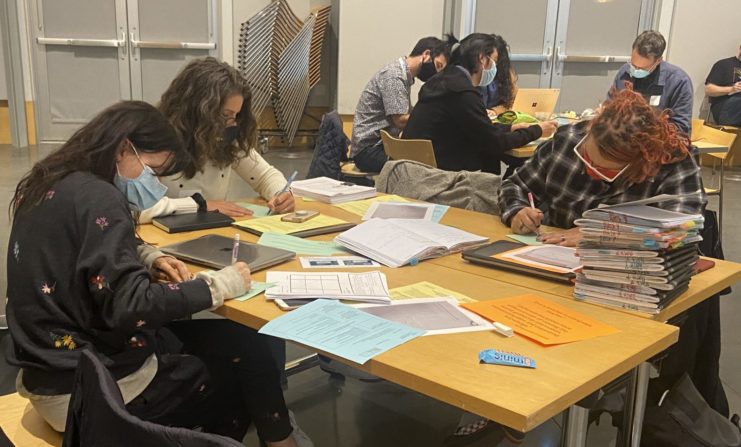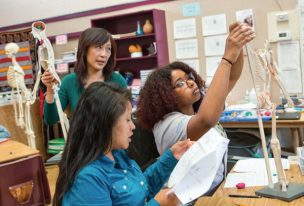
The Power of a Mid-Year Collective Pause
At a recent Lead by Learning session, facilitators created space for a collective pause. 23 elementary school teachers began to take out their notes and student data from the first half of the school year all connected to their site’s umbrella focus of improving student writing. Folders and backpacks became treasure troves of focal student work and past think alone reflections. The room quickly became quiet with concentration and smiles and educators recounted where they started in their inquiries in comparison to where they were now.
After this magical ten minutes to think alone, a Public Learner was invited to share aloud. While typically a Public Learner reflects on just their most recent data, this Public Learner was given an opportunity to model the important skill of looking at their data over time, what had changed and what hadn’t, in relation to their goals and indicators of success.
“I had really hoped by now that they would be able to write coherent sentences using descriptive language,” the teacher shared. “What I am seeing in the data, is that while they are using more and more descriptive language their use of connection words and conjunctions seem to be holding them back. I think I want help thinking about how to refine my indicators.” As the teacher shared vulnerably, their colleagues took notes.
As their 3 minutes of sharing concluded, everyone looked at the data collectively that this Public Learner had shared. Colleagues leaned in, took notes, and began asking probing questions to help this teacher’s thinking at this critical mid-year moment and next steps were named.
With this model of vulnerability, the entire staff began to have these powerful conversations about their own practice around teaching writing and their students’ experience. The room was alive as they all talked about their improvements in writing instruction and what was working and what clearly wasn’t.
After meeting in small groups, the Lead by Learning facilitator and school leader engaged in a sense-making conversation about what teachers had realized worked and hadn’t worked for student writing. An anchor chart began to grow of so many exciting practices and the staff was clearly fired up for the second half of the year.
While pausing at the middle of the year to look at data is not unique, the way in which it happened in many ways was. Before partnering with Lead by Learning, many school leaders, including the leader of this site, shared frustration around incorporating data into professional learning. What we see is they often engage in these pauses in the typical way using large satellite data of test scores or grades that leave their teachers feeling blamed and deflated. To educators, it feels like they see the same data year after year and the data feels disconnected to their day to day and the hard work they are putting in for their kids. To the leaders, this data reinforces the urgency they feel for change and the disconnect between the two groups is palpable. There are few smiles and in its place lots of folded arms and disengagement.
Over the years of facilitating many Collective Pauses that support progress monitoring and teacher collective efficacy, three aspects of Adult Learning design are essential for success.
- The data educators will be making sense of alone and together.
- The learning educators will be supported to engage in. In the story above, the learning was about what worked or didn’t work in terms of writing instruction.
- The conditions that need to be in place for their adult learners to have vulnerable, honest conversations grounded in data.
The Data
At the middle of the school year, there is a variety of data to look at. For the school above, the data was individual teachers’ data over time from focal students. For other sites, this street-level data might be put alongside other grain sizes of data such as a mid-year assessment, unit exams, or even external testing data such as reading or math scores. By placing formative assessment data next to summative assessment data there is an opportunity to really reflect on how students skills are showing up when and where.
In deciding the right data, we invite school leaders or designers of adult learning to partner with their teachers and elicit feedback on what data they feel would be most impactful to reflect on their practice in relation to the school goals set. What data will help them see the story both on the student level and site level?
The Learning
Now that the data has been selected it is important to think about how educators will learn from that data. Just like in the classroom, a presentation from a site leader or a “sage on the stage” approach will often fall short. At Lead by Learning, always create space for an educator or team of educators to model the learning as well as provide ample time for teachers to reflect both individually and collectively. The strength of one’s reflection lies in the questions asked. These questions serve as guideposts for adult learners’ thinking. Two central questions to hold when designing learning is to think about (1) What is most important for colleagues to think about? And, (2) What does the community need help making sense of together?
In our data dig tool, we outline powerful questions to support data analysis. Some of these include:
- What was our goal for students?
- What do we notice in the data? What does it tell us about our learners in relation to the goal?
- What does this data reveal about our work? What does the data not tell us and what assumptions might we be making to fill in for what we can’t see in the data?
- How can we shift our practice based on what we are learning?
The Conditions
Often times when we see mid-year conversations about data fall short, or flat on their face, is because attention is not paid to the conditions needed for educators to have honest, reflective conversations. When overlooked, learning cannot happen. A leader can have amazing questions and amazing data for their staff to dig into, but if the conditions are not set that allows colleagues to have honest and vulnerable conversations what tends to rise to the surface instead is defensiveness.
While ideally conditions are set all year and strengthened during every professional learning moment, we know this can’t always be the case. We like to support our leaders to think about the mindsets they want their teams to hold while engaging in the learning and then plan the learning with a focus on developing that mindset. As we like to say, the magic is in the mindset not the protocol or structure. After that mindset is determined, some questions to guide your design of adult learning might be:
- How might your ideal conditions be modeled through a fishbowl of a Public Learner, video, or even common text to clarify what success will look like, sound like, and feel like?
- How do your questions gradually allow your educators to develop the intended mindset? Are they open ended enough? Do the questions leave space for wonderings and unknowns?
- Is there space to both think alone and think together?
- What needs to be said explicitly about expectations and norms during both individual think time, collaborative think together time, and whole group sense-making?
And remember, everything is data. What are you, as a learner, learning about your adult learning community and leadership through facilitating this experience?

